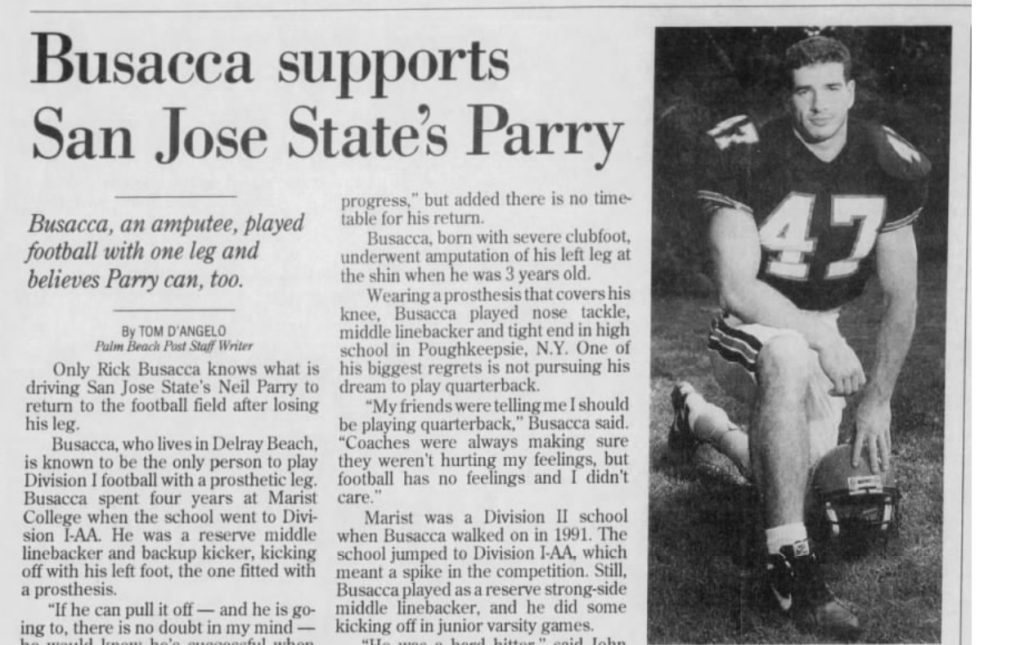We’re not huge college football fans (pay the players!), but the new season did bring some news that caught our eye. Derek Loccident, a senior at the University of Central Oklahoma, returned to the lineup three years after losing his left leg below the knee. Originally a defensive back (and a very good one at that), Loccident has shifted to linebacker for his senior year. He’s playing on a reinforced Flex-Foot Cheetah and hitting ball carriers as hard as ever, by all accounts. As far as we know, he’s the only NCAA gridder this season who’s suiting up with a prosthetic leg. More on his story here.
Loccident joins an elite fraternity of lower-limb amputees who’ve played college football at the NCAA level. An hour-long Google search only turned up a handful of other names. Most recently, DJ Vanderwerf (now a member of the LS Warriors amputee baseball team) made the roster at Eastern Tennessee State as a walk-on quarterback in 2016, although he doesn’t appear to have gotten into a game. The previous fall, Koni Dole played some linebacker for Montana State University. And Kody Kasey, an NAIA player for Kentucky’s Georgetown College, played cornerback and returned punts while wearing a prosthetic leg in 2016 and 2017.

Without question, the most prominent NCAA player to wear a prosthetic leg was Neil Parry, who made national headlines back in 2003 when he joined the punt-return unit for San Jose State University. Parry had lost his right leg after an injury on the same field three years earlier—his tibia snapped during a play, infection set in, and the amputation took place in a matter of days. He endured 25 subsequent surgeries, at least some of which were specifically meant to modify his residual limb for the rigors of football. When he finally returned to action for a home game against the University of Nevada, the nation’s news media descended en masse. CNN was there, along with the Today show, ESPN, Fox Sports, Sports Illustrated, the New York Times, the Associated Press, and a horde of other outlets. There were even some credible whispers that former president Bill Clinton might attend.
After the game, Parry was in such demand that Amplitude‘s partner publication, the O&P EDGE—the leading magazine for the prosthetic industry—wasn’t able to get onto his calendar for an interview. (He made the cover anyway.) NFL Films made a 20-minute film about Parry and his older brother, Josh, who spent three seasons in the NFL. College basketball coach Jim Valvano’s V Foundation gave Parry a “Never Give Up” award, and he was nominated for an ESPY in 2004 for Best Comeback Story. Parry went on to coach at San Jose State and the University of California at Davis, before settling in at his current position at Saint Francis High School in Mountain View, CA.
Given the wall-to-wall coverage Parry’s comeback received, we assumed he must have been the first player to chase the ol’ pigskin on a prosthetic leg. But buried deep within the coverage of his return back in 2003, there’s mention of a defensive lineman named Richard Busacca who wore a prosthetic leg while playing for Marist University in 1994. Nobody appears to have taken any notice of Busacca’s feat at the time, because we can’t find a shred of contemporaneous media coverage—this despite the fact that Marist is located within a couple of hours of New York City.

The only trace of Busacca’s story we turned up was a newspaper article from August 2003, during the buildup to Neil Parry’s return to the gridiron. The Palm Beach Post caught up with Busacca, who was coaching youth football in nearby Boca Raton, to get his thoughts about the hoopla around Parry. Then 32 years old, Busacca told the Post: “If he can pull it off—and he is going to, there’s no doubt in my mind—he would know he’s successful when nobody cares [about his limb difference], when you are no longer treated differently. . . . A lot of people didn’t grasp what I was doing. The whole point of this is trying to be equal.”
A native of Poughkeepsie, New York (where Marist is located), Busacca was born with clubfoot and had his left leg amputated above the ankle at age three. He played on both offense and defense in high school, then made the Marist team as a freshman walk-on in 1991. The Post article lists him as a reserve linebacker and says he played five games during his senior season in 1994.
“Football is like life,” Busacca told the Post in a parting bit of wisdom. “You are going to get hit, knocked down—it’s whether or not you get back up.”
For the sake of completion, we should also mention Brian Hall, a placekicker who played for Texas Tech in the mid-1970s, nearly 20 years before Busacca made the Marist roster. Hall lost his right foot in a childhood farm accident, and he booted the ball through the uprights with his prosthetic limb. He was very good at it, too: In his senior year Hall set a new school record for field goals in a season. We think kicking FGs with an artificial leg is pretty cool, but it didn’t seem to impress the horde of sportswriters who celebrated Neil Parry’s comeback for San Jose State. Several of those reporters mentioned Hall’s tenure at Texas Tech, but not one credited him as being the first amputee player—presumably because he didn’t have to run, block, or tackle on his prosthesis. To put this more bluntly: Hardly anyone regards placekickers as “real” football players.
Should Hall go down as the trailblazing player, or would you give the title to Busacca? We’ll leave that to your discretion. Put us down for the kid from Marist.



